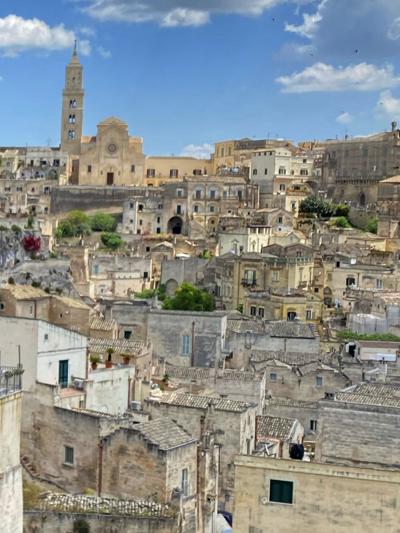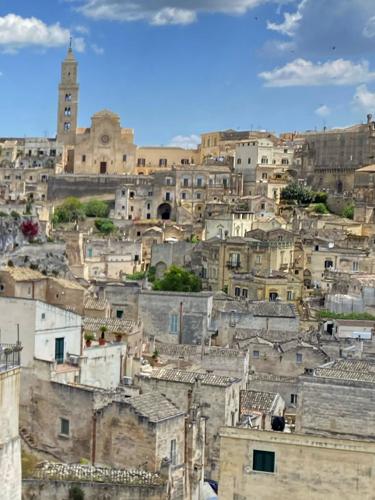There’s a reason why we found ourselves in a somewhat removed portion of Italy recently where there are few crowds of tourists and practically no Americans. And that’s because the last time we visited, several years ago, the opposite was true. Part of the reason may have had to do with the time of year — October, a beautiful month anywhere — and part of it may have had to do with locations themselves.
Venice and Florence, though two of the most beautiful cities in the world, were both completely overwhelmed with hordes of people the last time we visited. Cruise ships had taken over the Giudecca and Grand Canals of Venice (a problem Venetian authorities are addressing) and we couldn’t even get close to the Uffizi Gallery in Florence. Besides that, it was very nice walking around both cities with tens of thousands of our closest friends.
So it was a refreshing change to wake up in the hilltop town of Bernalda one morning a couple of weeks ago. Bernalda (which dates back to 1099 and then known as Camarda) is in the Southern Italian region of Basilicata, comprising the “arch” or instep of the Italian “boot.”
We were alone at breakfast, and the only language we heard spoken en route by foot to our first stop of the day, a family-owned and operated cheese shop, was Italian. (“Godfather” film fans might be interested in knowing that Francis Ford Coppola’s ancestral roots are in Bernalda and that the famed director actually bought a 19th century Bernaldan palazzo, converted it to a hotel and a beautiful place that his children and others would want to return time and again.)
Southern Italy is well-known, among other things, for its thriving local agriculture, citrus, vineyards, olive groves and cheese-making. The Caseificio il Mastello (roughly translated as Mastello family cheese-making), is a classic multi-generational family business supported by the people of Bernalda. Though it has an Instagram page, the family — quite unlike the situation with most American family businesses — does not place an emphasis on social media because it’s unnecessary. There’s more than enough local and word-of-mouth demand to make everyone happy.
The senior mistress (I didn’t catch her first name) runs the retail section of the store up front. Her husband and his sister, Nunio and Bernaldina (I love that), make a variety of cheeses out back with the assistance of Leonardo, son of Nunio, and the lady just mentioned above. Leonardo has completed 16 years of “apprenticeship,” and Nunio admits — cheerfully yet with playful hesitation — that Leonardo has mastered the family craft.
Even though that craft doesn’t necessarily require a whole lot of ingredients, it does require absolute precision regarding temperature, cooking, manipulation and the way things are put together. The family staple, mozzarella, only requires milk, salt, rennet and heat. But try factoring in timing, mixing, temperature, separation and so forth and it’s not as easy as it might sound, although probably the easiest prepared of the cheeses made in house. Others include burrata (with the thicker skin and creamier interior), caciocavello, ricotta, stracciatella (the creamy component on the inside of burrata), and some others.
James Bond fans might have been intrigued by the beautifully situated, if action-packed, opening scenes of the latest movie in the series, “No Time to Die.” That afternoon we drove to Matera, which is where most of the opening scenes were shot (but not the bridge scene, filmed at the Ponte dell’Acquedotto di Gravinia in the region of Puglia.)
Matera is quite literally one gigantic sandstone and limestone sculpture, dating back to cave dwellers that took up residence during the Paleolithic Age (10th millennium B.C.). There are no architectural masterpieces per se, and yet its overall appearance is wonderfully unique, representing a remarkable example of man adapting to harsh environmental conditions instead of trying to conquer them in order to create something completely unrelated to the environment. Though caves would remain a considered necessity (for chilled storage, if nothing else). Walls, stairs, floors and roofs were literally carved out of the limestone through the centuries — as was a massive cistern — and stone blocks were used to build upward and outward.
As recently as the 1950s, though, some of the residents of Matera were still living in unmodified caves, a situation the Italian prime minister considered a disgraceful and intolerable 20th century embarrassment. The population was relocated to modern housing (which sadly and ironically destroyed its sense of community) and the Sassi (Italian for “stones”) lay abandoned until the 1980s, when renewed investment led to improvements and upgrades. The cave dwellings and surrounds became not only destinations of historic interest, but alive with activity, including an arts community, hotels, small museums and restaurants and expensive private residences.
Matera was named a UNESCO World Heritage Site (of which there are several in Southern Italy) in 1993, and in 2019 was designated a European Capital of Culture.
The above comprised one day’s activities. We stayed at our home base in Bernalda, drove the rental car everywhere, and if all that weren’t enough, my wife upped and stepped on a venomous asp in the mountain town of Pietrapertosa, which very considerately did not bite.
Thank goodness — we wouldn’t have been too interested in determining whether or not Cleopatra’s outcome was a fluke.










